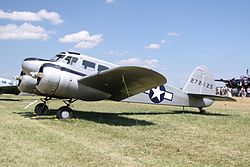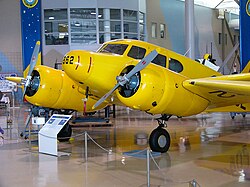Cessna T-50
| Cessna T-50, AT-17 / UC-78 Bobcat | |
|---|---|
 the civilian basic model Cessna T-50 |
|
| Type: | Light aircraft |
| Design country: | |
| Manufacturer: | |
| First flight: |
March 26, 1939 |
| Commissioning: |
1939 |
| Production time: |
1939 to 1944 |
| Number of pieces: |
approx. 5400 |
The Cessna T-50 (officially Cessna Model T-50) was a light five-seat transport aircraft produced by the American manufacturer Cessna Aircraft Company . The Cessna AT-17 Bobcat military training aircraft and the Cessna UC-78 Bobcat military liaison aircraft were created from the basic civilian model .
history

The Model T-50 was the first twin-engine aircraft type made by the manufacturer Cessna and made its maiden flight on March 26, 1939. Series production began in the same year. Initially, the aircraft was only manufactured as a civilian model and delivered in small numbers.
In 1940 the US Army Air Corps acquired 33 Cessna T-50s to test them out as training aircraft. The aircraft received the military designation AT-8 ( A dvanced T Rainer). At the end of 1940, the Royal Canadian Air Force ( RCAF ) placed an order for an initial 550 Cessna T-50s in order to retrain pilots from single to twin-engine aircraft as part of the Commonwealth Air Training Plan . The Canadian training aircraft were named Crane 1 . The delivery took place from January 1941. The RCAF also used the Crane 1 for training in flight navigation and as a liaison aircraft.
According to the US Army Air Corps , their 33 AT-8 test machines were over-powered for training purposes. For the training aircraft ordered in large numbers from 1941 onwards, less powerful engines were selected, from which the AT-17 Bobcat emerged .
In 1942 the United States Army Air Forces ( USAAF ) decided to use the machines for light transport and connection tasks. The transport aircraft were initially given the designation C-78 , which was changed to UC-78 Bobcat in early 1943 . Because the US armed forces had no need for further training aircraft at the end of 1942, the outstanding orders were converted and instead transport aircraft of the UC-78B and UC-78C versions were delivered. In 1942, the US Navy placed an order for another 67 UC-78s, which had different equipment and were used to transport transfer pilots back. These machines received the classification JRC-1 .
After World War II, the Canadian and US forces decommissioned most of their aircraft by 1947. Many machines were given to friendly air forces or sold to civil companies. In German-speaking countries, the Swiss company Balair and the German Südflug company used Cessna UC- 78s that they had acquired second-hand.
construction
The Cessna T-50 was as low-wing aircraft designed and was strong by two per 220 kW (295 hp) air-cooled Neunzylinder- radial engines of the type Lycoming R-680 driven -9. The military series AT-17 and UC-78 had two seven-cylinder Jacobs R-755-9 star engines, each with 183 kW (245 hp).
The hull of all civil and military versions consisted of a welded tubular steel construction, which was clad with light wood panels and covered with a final layer of fabric. The wings and the tail unit had a frame construction and planking made of wood. The landing gear and the landing flaps were operated electrically.
Versions
- T-50
- five-seater civil transport aircraft with two 295 hp (220 kW) Lycoming R-680 -9 engines
- AT-8
- military training aircraft based on the basic model T-50 (33 units built)
- AT-17
- military training aircraft with two 245 HP (183 kW) engines of the type Jacobs R-755-9 (450 units built)
- AT-17A
- based on the AT-17, but instead of wooden propellers with controllable pitch propellers made of metal (223 built copies, of which 182 were loaned to Canada)
- AT-17B
- based on the AT-17A, but with modified basic equipment (466 built copies, partly completed as UC-78B)
- AT-17C
- based on the AT-17A, but equipped with other radios (60 units built)
- AT-17D
- based on the AT-17A, but with slightly different equipment (131 built, all delivered as UC-78C).
- C-78
- light transport and liaison aircraft for the USAAF based on the AT-17 (1287 units built)
- UC-78
- identical to the C-78, the changed designation was used from 1943
- UC-78A
- Designation for 17 civilian Cessna T-50s taken over by the USAAF
- UC-78B
- based on the AT-17B, but with propellers made of wood (specimens built in 1806)
- UC-78C
- based on the AT-17D, but with propellers made of wood (327 units built)
- JRC-1
- light transport aircraft for the US Navy based on the UC-78 (67 units built)
- Crane 1
- Cessna T-50 acquired from the Royal Canadian Air Force , used as training and liaison aircraft (640 units built)
- Crane 1A
- Canadian designation for the AT-17A, 182 copies were loaned from the USA to Canada
Production for the USAAF
Acceptance of the Cessna T-50 by the USAAF:
| version | 1940 | 1941 | 1942 | 1943 | 1944 | TOTAL |
|---|---|---|---|---|---|---|
| AT-8 | 6th | 27 | 33 | |||
| Crane Mk. I. | 569 | 71 | 640 | |||
| AT-17 | 22nd | 428 | 450 | |||
| AT-17A | 223 | 223 | ||||
| AT-17B | 466 | 466 | ||||
| AT-17C | 60 | 60 | ||||
| AT-17D | 131 | 131 | ||||
| C-78 | 187 | 1,167 | 1,354 | |||
| UC-78B | 1,531 | 275 | 1,806 | |||
| UC-78C | 196 | 196 | ||||
| TOTAL | 6th | 618 | 1,435 | 2,829 | 471 | 5,359 |
Technical data of the UC-78
| Parameter | Data |
|---|---|
| crew | 1 |
| Passengers | 4th |
| length | 9.98 m |
| span | 12.78 m |
| height | 3.02 m |
| Wing area | 27.41 m² |
| Empty mass | 1588 kg |
| Max. Takeoff mass | 2585 kg |
| Cruising speed | 282 km / h |
| Top speed | 314 km / h |
| Service ceiling | 6705 m |
| Range | 1207 km |
| Engines | 2 × Jacobs R-755-9, each 183 kW (245 PS) |
See also
Web links
Individual evidence
- ↑ a b c Aero, issue 49, year 1984
- ↑ Statistical Digest of the USAF 1946, p. 100 ff .; www.uswarplanes.net



